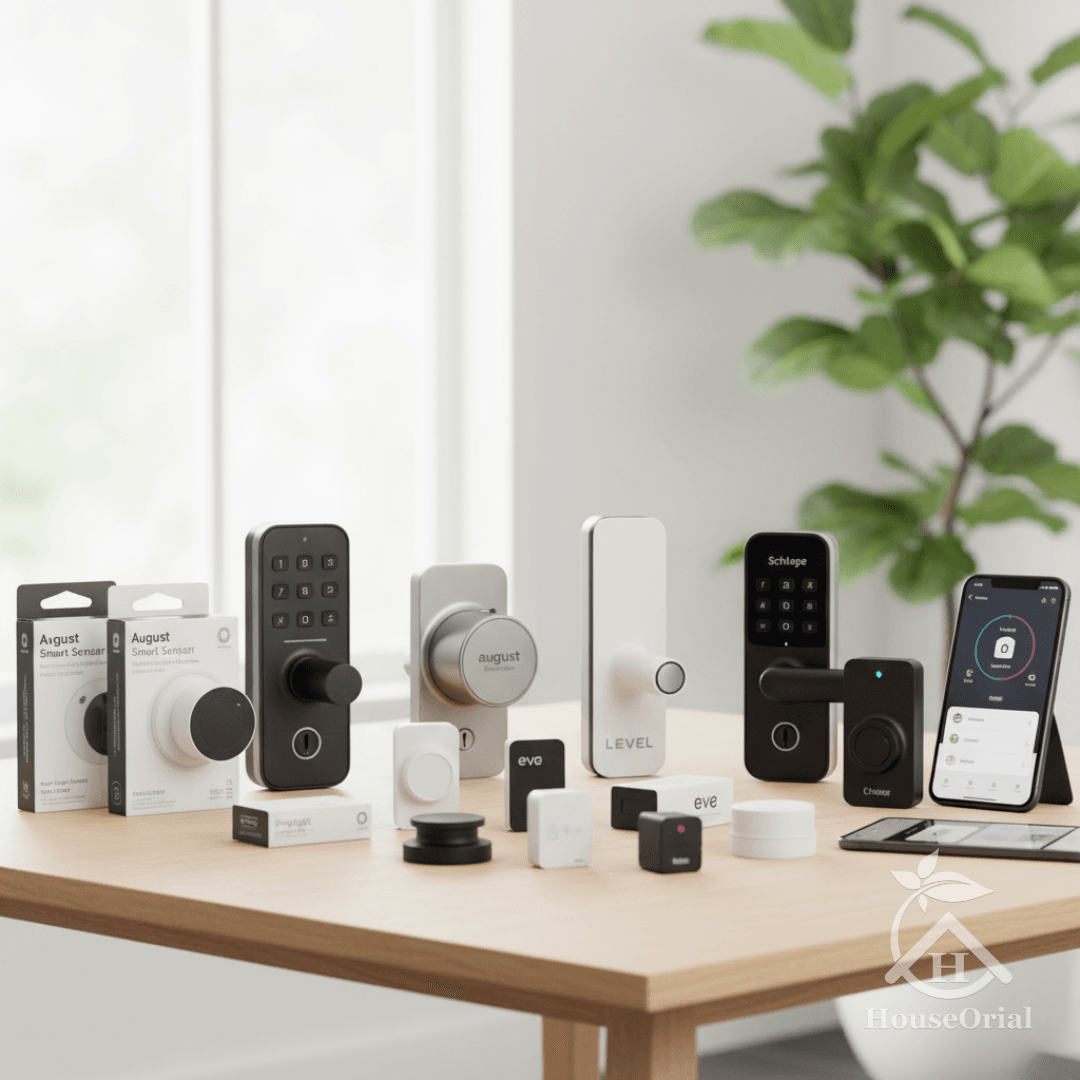Finding the best home security systems for apartments doesn’t have to be complicated. Today’s options are wireless, tenant-friendly, and easy to set up yourself, with no long-term contracts or messy wiring.
Top-rated choices like SimpliSafe, Ring Alarm, and Cove offer modern solutions that anyone can install in minutes. SimpliSafe is ideal for quick setup and flexible monitoring. If you use Amazon Alexa or other smart devices, Ring Alarm integrates seamlessly and adds extra peace of mind. And for those looking for budget-friendly protection, Cove delivers excellent value without compromising safety.
If you prefer professional installation and 24/7 monitoring, trusted brands like ADT still provide reliable, hands-on solutions. No matter your style or budget, securing your apartment has never been easier—or smarter!
Table of Contents
Types of Best Home Security Systems for Apartments
1. Wireless Security Systems
What is Wireless Security Systems?
A wireless security system is a modern home protection setup that works without messy wires or drilling holes. Instead of using cables, it connects all its components—such as cameras, sensors, and alarms—through Wi-Fi, Bluetooth, or cellular networks.
These systems are easy to install and ideal for apartments or rented homes. You can control and monitor everything through a smartphone app, get instant alerts if anything unusual happens, and even connect the system with smart devices like Alexa or Google Home for extra convenience. In short, wireless security systems make home protection simple, smart, and flexible—no tools or professional help required.
Popular options: SimpliSafe, Ring Alarm
Pros:
- Easy DIY installation
- Flexible sensor placement
- Portable when moving
- Smart device integration
Cons:
- Limited advanced monitoring
- Requires battery replacement
Setup Guide:
- Place base station near entrance
- Mount door/window sensors
- Connect sensors via mobile app
- Test all alarms and notifications
Maintenance Tips:
- Check battery monthly
- Update firmware via app
User Reviews :
“I deeply regret purchasing the SimpliSafe system. The hardware is cheaply made, and the system frequently goes offline.”
— Reddit user (source)
“Quality of videos same as cheaper competitors. Cloud recording costs $10/month, which was not advertised.”
— Trustpilot review (source)
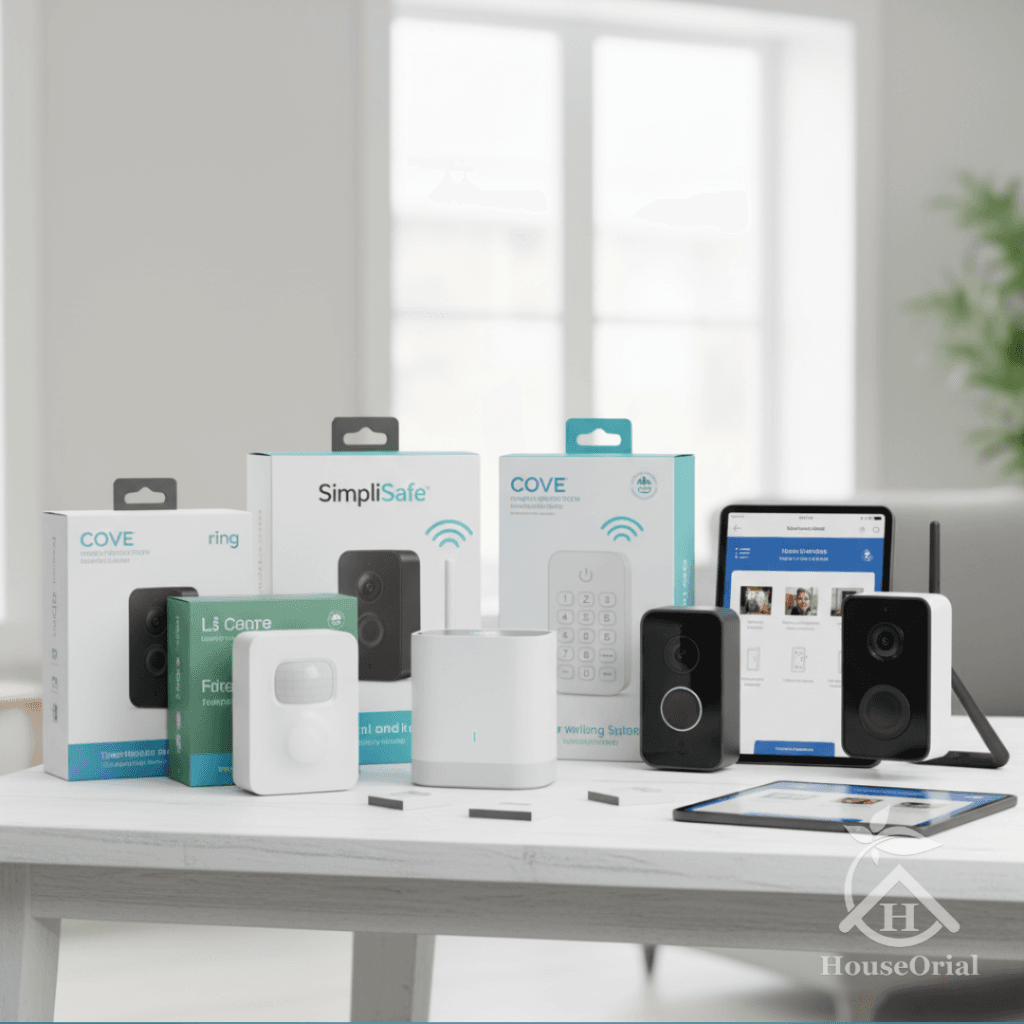
2. Video Doorbells
What is Video Doorbells?
Video doorbells offer a simple way to monitor your front door. They show who is outside before you open the door. Many send live video to your smartphone. This option suits apartment dwellers who want extra peace of mind. It helps prevent unwanted visitors and package theft.
Examples: Ring Video Doorbell 4, Nest Hello
Pros:
- Two-way communication
- Motion detection
- Real-time alerts
Cons:
- Wi-Fi dependency
- Cloud storage requires subscription
Setup Instructions:
- Mount at eye level near entrance
- Connect to Wi-Fi and sync with app
- Enable motion zones
User Reviews:
“Hate it. Very bad customer service. Works out expensive when adding more devices.”
— Reddit user (source)
“Ring Alarm 2nd Gen is affordable with easy DIY setup but lacks advanced features.”
— SafeHome.org (source)
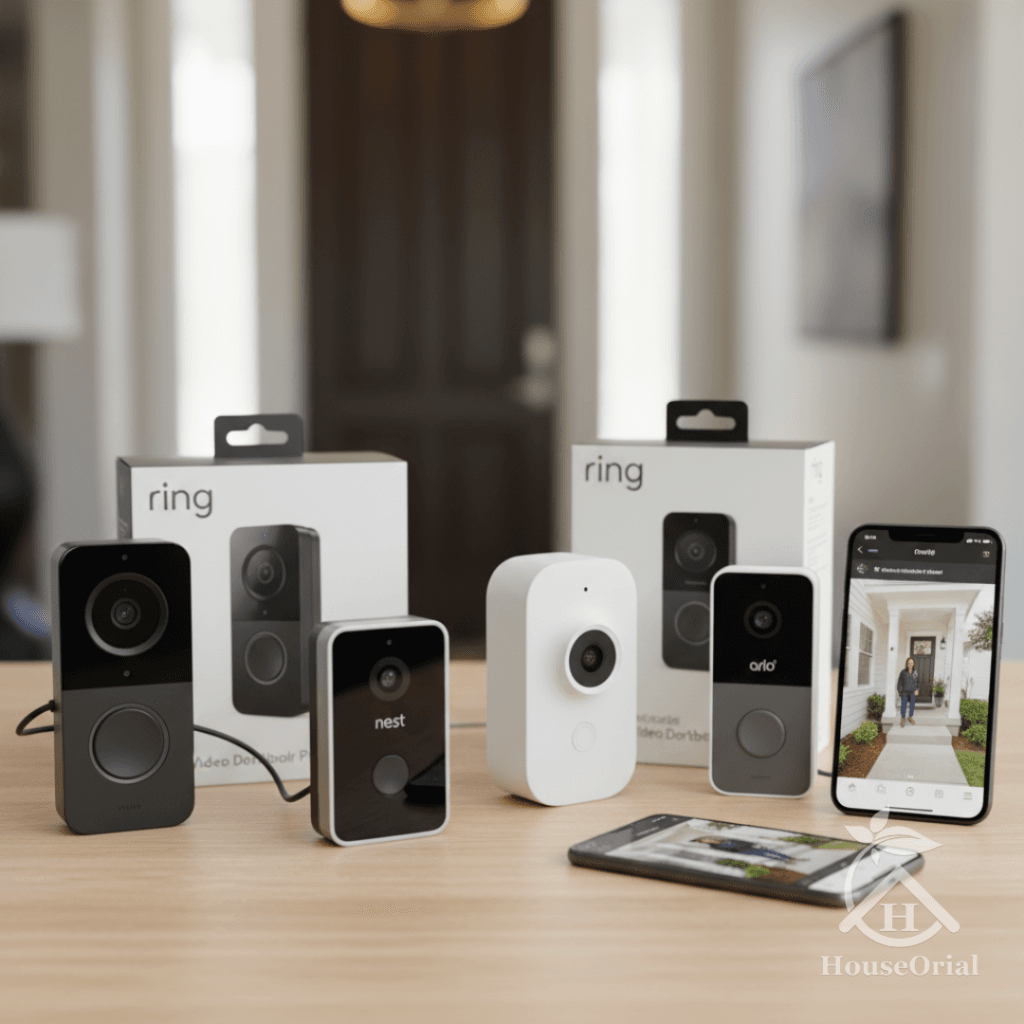
Also Read: The Truth About Home Security Systems: According to experts.
Average cost of home security system: What You Need to Know
How to Protect Your Home without a Security System – 2025
11 Cheap ways to secure your home
How to secure windows from break-ins
3. Smart Locks & Door Sensors.
What is Smart Locks ?
Smart locks and door sensors are essential tools for apartment security systems. Smart locks let you lock and unlock your doors using a smartphone, key code, or fingerprint, so you don’t need traditional keys. They also allow you to give temporary access to friends, family, or service providers without handing over a physical key.
What is Door sensors?
Door sensors, on the other hand, alert you instantly if a door or window is opened unexpectedly. These sensors are small, easy to install, and can be connected to your security system or smartphone app. Together, smart locks and door sensors make your apartment safer, smarter, and more convenient, giving you peace of mind even when you’re away.
Pros:
- Remote lock/unlock
- Access control for guests
- Integration with smart devices
Cons:
- Higher initial cost
- Requires Wi-Fi for full features
Setup Guide:
- Remove existing lock
- Install smart lock
- Sync with app
- Test manual and remote locking
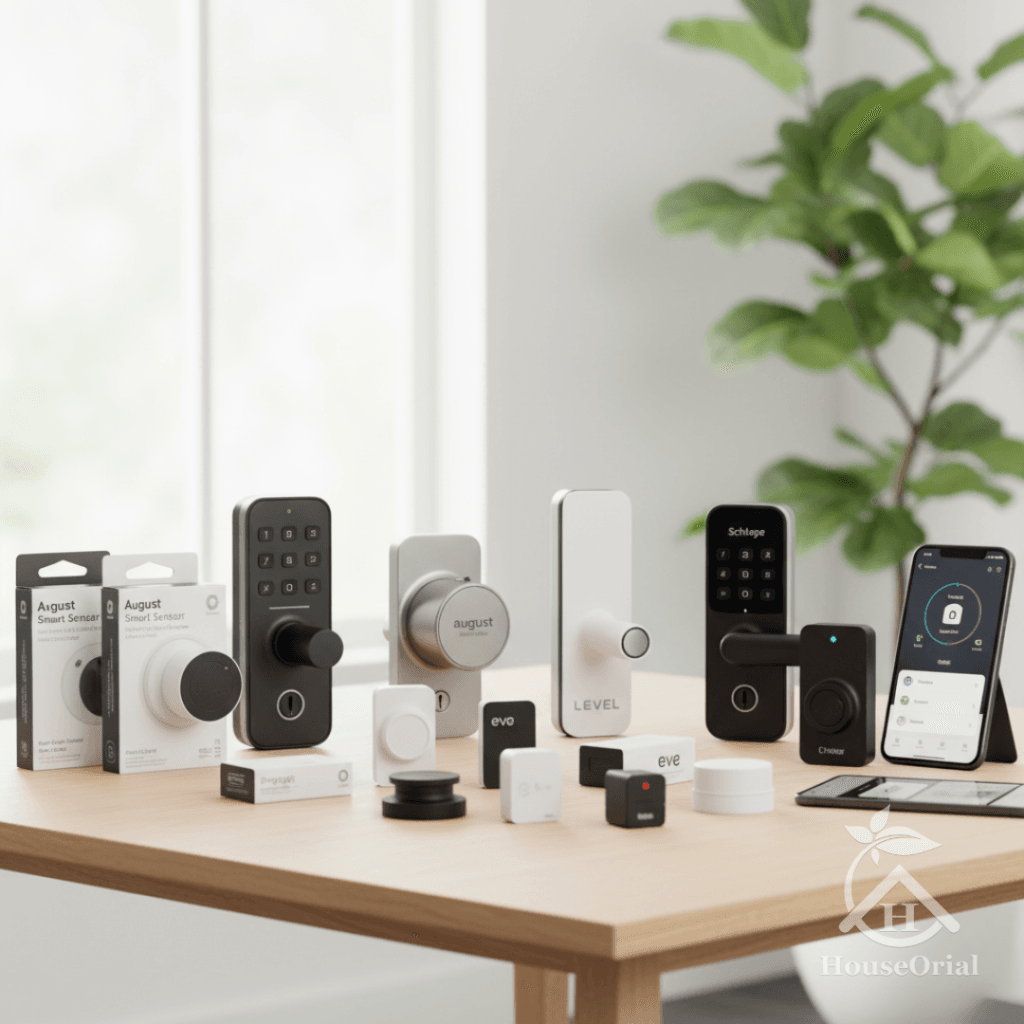
4. Indoor Cameras
What is Indoor Camera?
Indoor cameras are fundamental to comprehensive apartment security. They let you see what’s happening inside your home from anywhere using your smartphone. Most modern indoor cameras also come with motion detection, so you get alerts if there’s unexpected movement.
Many indoor cameras include two-way audio, which allows you to talk to anyone inside your apartment through the camera—perfect for checking on pets, kids, or visitors. Some models even offer night vision and cloud storage for recorded videos, making sure you never miss important moments.
With indoor cameras, you can keep an eye on your apartment 24/7, even when you’re away, giving you extra peace of mind and control over your home security.
Examples: Arlo Pro 4, Nest Cam Indoor
Pros:
- Compact and motion-detecting
- Smart integration
Cons:
- Limited to indoor coverage
- Continuous recording uses more storage
Setup Instructions:
- Place camera in corner or shelf
- Connect to Wi-Fi
- Sync with app
- Adjust motion sensitivity
User Reviews:
“The Arlo Pro 4 offers 2K resolution, AI detections, and Wi-Fi connectivity but requires a subscription for full features.”
— SafeHome.org (source)
“My Arlos takes about 12 seconds to show a live feed on average.”
— Reddit user (source)
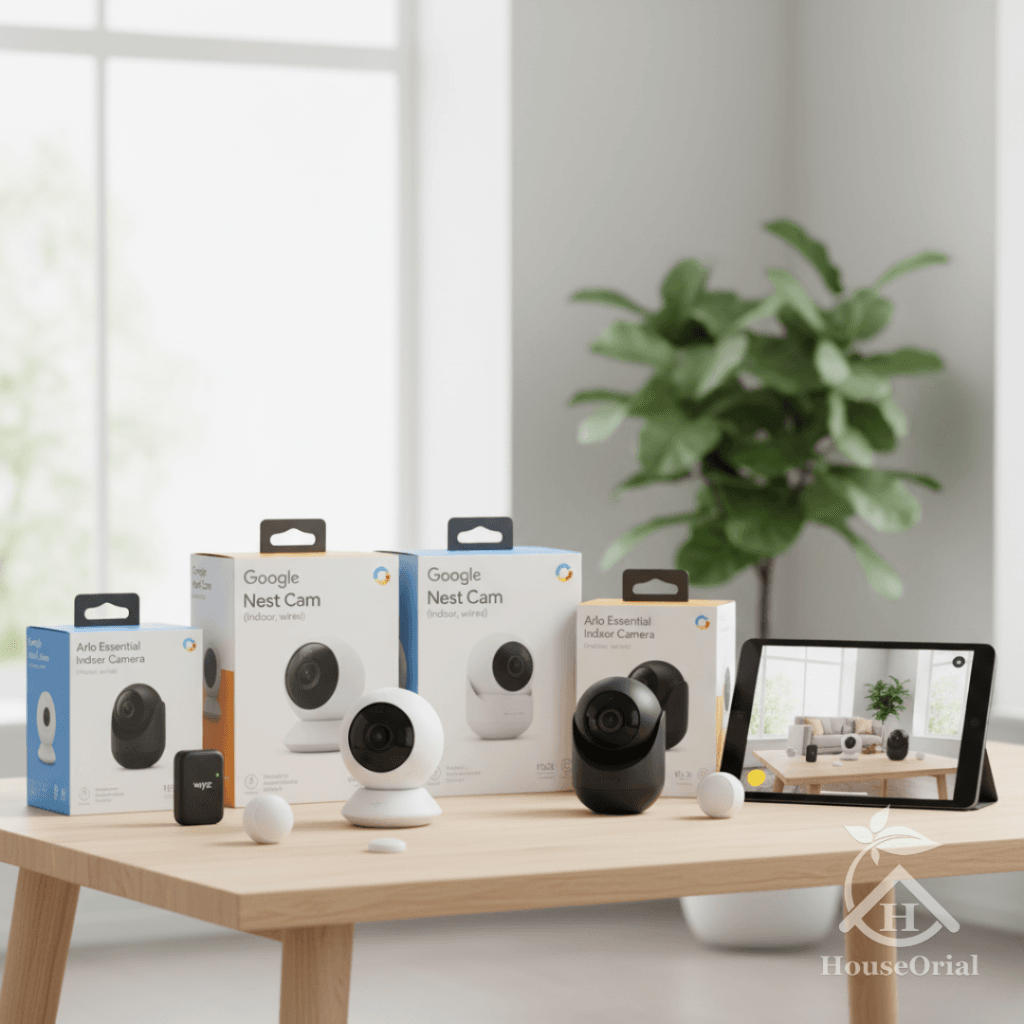
5. Noise And Motion Detection
Noise and motion detection are key for catching unusual activity early. These sensors trigger alarms or alerts when something moves or makes sound in your apartment.
Pros:
- Instant alerts: You get notifications on your smartphone if there’s unusual movement or loud noise.
- 24/7 monitoring: Helps keep your apartment safe even when you’re away.
- Energy and space saving: Only triggers the alarm or camera when needed, so it doesn’t record unnecessarily.
Cons:
- False alarms: Pets, neighbors, or passing vehicles can sometimes trigger alerts.
- Battery usage: Motion or noise sensors may drain the battery faster if overactive.
- Privacy concerns: Some people may feel monitored if alerts are too frequent.
Why it’s best:
Noise and motion detection are ideal for apartments because they alert you instantly without constant monitoring, making your home safer without being intrusive.
User Reviews:
Many users love these features, saying they feel more secure even when traveling. Some note occasional false alarms, but most agree the peace of mind is worth it.
Comparison Table: Best Home Security Systems for Apartments
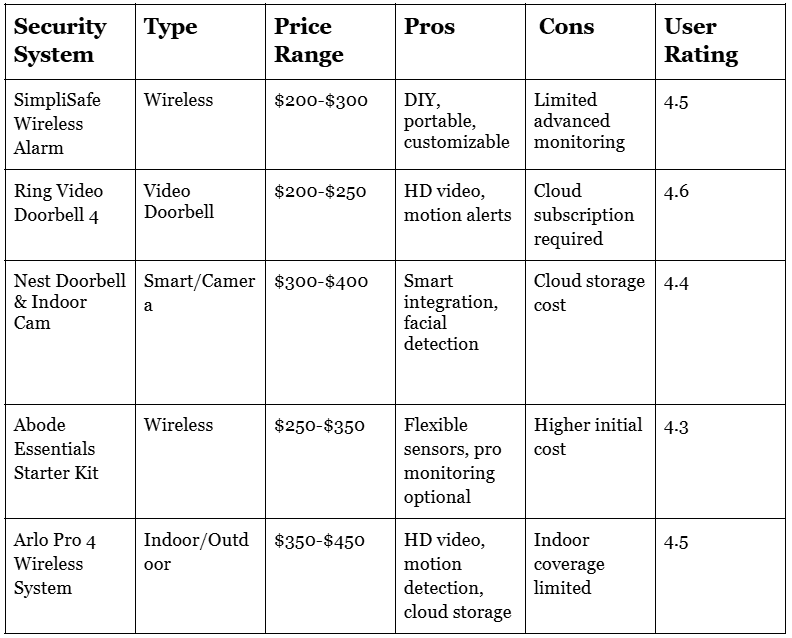
Best DIY Home Security Systems for Apartments.
Choosing the best DIY security options for apartments helps protect your home without high costs or complex setups. DIY kits give control over your safety with easy tools and flexible features. These systems fit well in apartments, where space and lease rules limit permanent changes. They offer practical solutions with simple installation and smart alerts. This section shows top DIY choices for apartment security that anyone can install and manage.
Affordable Kits
Affordable DIY security kits make apartment safety possible for many budgets. These kits include essential devices like sensors, cameras, and alarms in one package. Buying a kit is cheaper than buying parts separately. Many kits cost under $200, giving good value.
Common items in affordable kits:
- Door and window sensors
- Motion detectors
- Indoor security cameras
- Control panel or hub
- Mobile app access
Some kits offer extra features like smoke detectors or smart locks. Prices vary by brand and features. Here is a quick price comparison for popular kits:
| Kit Name | Price Range | Devices Included | App Control |
| SecureHome Basic | $100 – $150 | 3 sensors, 1 camera, hub | Yes |
| SafeNest Starter | $120 – $180 | 4 sensors, 2 cameras, hub | Yes |
| ProtectPlus Lite | $90 – $130 | 3 sensors, 1 alarm | Yes |
Affordable kits often include all basics to start securing your apartment. Extra devices can be added later as needed.
Easy Installation
DIY security systems focus on easy installation to suit apartment living. No special tools or drilling usually needed. Most devices use adhesive strips or magnets to attach to doors and walls. This makes removal simple when moving.
Steps for easy installation:
- Unpack all devices from the kit
- Download the system’s mobile app
- Follow app instructions to connect devices
- Place sensors on doors and windows
- Mount cameras in desired spots using included mounts or stands
- Test the system to ensure all devices work
Many systems use Wi-Fi or Bluetooth to connect devices. This avoids running wires through your apartment. Battery-powered sensors and cameras reduce the need for outlets.
Benefits of easy installation:
- No damage to walls or doors
- Quick setup in less than an hour
- Can be moved or expanded anytime
- User-friendly apps guide each step
This ease makes DIY kits ideal for renters who want security without permanent changes.
Customizable Alerts
Customizable alerts keep you informed about your apartment’s safety anytime. Most DIY systems send notifications to your phone or email. You can choose which alerts to receive and how often.
Types of alerts commonly available:
- Door or window opened
- Motion detected inside
- Camera activity or sound detected
- Low battery warnings
- System arm/disarm status
You can set alert preferences for different times or situations. For example, turn off motion alerts during the day but activate them at night. Some apps let you create “safe zones” or “quiet hours” to reduce false alarms.
Here is an example of alert customization options:
| Alert Type | Custom Options |
| Motion Detection | Set sensitivity, schedule active hours |
| Door/Window Sensor | Instant alert, delay option |
| Camera Activity | Motion zones, video recording start |
| Battery Status | Alert thresholds, reminder frequency |
These alerts help stay aware of unusual activities and respond quickly. Custom settings reduce noise from unnecessary notifications.
Professional Monitoring Services
Professional monitoring services play a crucial role in enhancing apartment security. These services connect your home security system to a team of experts who watch over your property around the clock. Unlike self-monitoring, professional monitoring ensures quick action during emergencies, providing peace of mind even when you are away. For apartment dwellers, this added layer of protection helps guard against break-ins, fires, and other hazards. The system alerts the monitoring center instantly if it detects unusual activity, triggering prompt intervention.
24/7 Surveillance
Continuous monitoring is the backbone of professional security services. The monitoring center operates 24 hours a day, 7 days a week, without breaks or downtime. This ensures that any alarm or signal from your apartment’s security system is noticed immediately.
Core capabilities of 24/7 surveillance include:
- Real-time alerts sent to monitoring staff
- Immediate verification of alarms to reduce false calls
- Constant camera feed review (if cameras are installed)
- Tracking of sensor activity like door/window openings
This nonstop attention helps detect threats early. For example, if a window sensor triggers at 2 AM, the monitoring team will check the alert and contact you or emergency services quickly. This rapid response can prevent theft or damage.
| Benefit | Description |
| Early Detection | Alarms are noticed immediately to stop incidents early. |
| False Alarm Reduction | Staff verify signals before calling emergency responders. |
| Peace of Mind | Knowing someone watches your apartment all day and night. |
Emergency Response
The core advantage of professional monitoring is the fast emergency response. When the system triggers an alarm, the monitoring center acts immediately. They follow strict protocols to handle various emergencies.
Here is how the emergency response process works:
- Alarm signal received by monitoring staff
- Staff contacts the apartment resident to verify the alert
- If no response or confirmed danger, emergency services are dispatched
- Follow-up with resident after emergency services arrive
This process helps avoid delays that may occur with self-monitoring. The monitoring center’s trained staff know how to handle different situations, such as:
- Burglary or break-in
- Fire or smoke detection
- Medical emergencies (if panic button is included)
- Carbon monoxide alerts
Professional monitoring can save lives and property by ensuring help arrives fast. This service is especially valuable for apartment dwellers who may not hear alarms or be home during emergencies.
Monthly Fees
Professional monitoring services usually require monthly fees. These fees cover the cost of the monitoring center’s staff, technology, and support. Prices vary depending on the provider and the level of service.
Common pricing models include:
- Basic monitoring: Covers alarm monitoring only, usually the lowest cost
- Full-service monitoring: Includes video surveillance, environmental sensors, and medical alerts
- Contract length: Some providers offer discounts for longer contracts
Here is a sample fee comparison table:
| Service Level | Monthly Fee | Features |
| Basic | $15 – $25 | Alarm monitoring, SMS alerts |
| Standard | $25 – $40 | Video monitoring, fire and CO detection |
| Premium | $40 – $60+ | Medical alerts, home automation integration |
Choosing a plan depends on your budget and security needs. Some services offer no-contract options for flexibility. Factor monthly fees into your overall apartment security budget.
Budget-Friendly Home Security Systems for Apartments
Choosing the right home security systems for an apartment can be tricky, especially with a tight budget. Budget-friendly choices help protect your space without costing too much. These options offer solid security features that fit small spaces and limited budgets. Simple setups, low monthly fees, and easy installation make these systems popular for apartment dwellers. This section covers basic alarm systems, affordable cameras, and subscription-free options that keep your home safe and your wallet happy.
Basic Alarm Systems
Basic alarm systems provide essential protection for apartments. These systems usually include door and window sensors and a loud siren to scare away intruders. They are easy to install and require minimal technical knowledge.
- Simple installation: Most kits come with adhesive sensors that stick to doors and windows.
- Instant alerts: Many systems send alarms directly to your phone or sound a loud siren.
- Low cost: Basic kits often cost less than $100.
Here is a quick comparison of common features in basic alarm kits:
| Feature | Included | Price Range |
| Door/Window Sensors | Yes | $30 – $60 |
| Siren/Alarm | Yes | Included |
| Mobile Alerts | Depends on model | Free to low-cost app |
Basic alarm systems do not need professional monitoring. This helps keep monthly costs low. They are perfect for renters who want simple, effective protection.
Affordable Cameras
Affordable cameras add visual security to apartments. These cameras help watch entrances and common areas without breaking the bank. Many models offer clear video, night vision, and easy setup.
- Wireless options: Avoid complicated wiring and install cameras quickly.
- Smartphone access: View live video anytime from your phone.
- Two-way audio: Talk to visitors or warn intruders through the camera.
Below is a table comparing some budget-friendly camera features:
| Camera Model | Resolution | Night Vision | Price |
| Model A | 1080p | Yes | $50 |
| Model B | 720p | Yes | $40 |
| Model C | 1080p | No | $35 |
Affordable cameras provide peace of mind. They help spot unusual activity early and keep your apartment safer without a big investment.
Subscription-free Options
Subscription-free security systems save money over time. These systems do not charge monthly fees for monitoring or cloud storage. Users keep control of their data and avoid ongoing costs.
- Local storage: Save video footage on SD cards or local drives.
- Self-monitoring: Receive alerts and check cameras without paying a service.
- One-time purchase: Buy the system once and use it freely.
Here are some benefits of subscription-free home security:
- Cost savings: No monthly payments.
- Privacy: Data stays in your control.
- Flexibility: Use the system as much as needed.
Many basic alarm systems and cameras offer subscription-free modes. Choose these options to keep your apartment safe without extra fees.
Smart Home Integration
Smart home integration is a key factor in choosing the best home security systems for apartments. It allows residents to connect their security devices with other smart gadgets, creating a seamless and efficient safety network. This integration enhances convenience and control, making it easier to monitor and protect your apartment. Smart home systems are designed to work together, giving you more options to customize your security setup.
Voice Assistant Compatibility
Many modern home security systems support voice assistants like Amazon Alexa, Google Assistant, and Apple Siri. This compatibility lets you control your security devices using simple voice commands. For apartment dwellers, this means you can arm or disarm your system without touching any buttons.
Benefits of voice assistant compatibility include:
- Hands-free control of alarms, cameras, and locks
- Quick status updates with simple questions
- Integration with other smart devices for better convenience
Here is a table showing popular voice assistants and their features with security systems:
| Voice Assistant | Supported Commands | Compatible Devices |
| Amazon Alexa | Arm/disarm, camera view, status check | Locks, cameras, alarms, lights |
| Google Assistant | System control, alerts, device status | Alarms, cameras, smart plugs |
| Apple Siri | Activate scenes, lock/unlock doors | Locks, sensors, alarms |
Using voice assistants makes managing your apartment security faster and safer. It removes the need to find your phone or keypad during emergencies.
Automation Features
Automation features allow your home security system to work on its own based on set rules. These features improve safety and comfort by reacting automatically to different situations.
Examples of useful automation features for apartments:
- Scheduled Arming: Automatically arm your system at night or when you leave.
- Motion-triggered Lights: Turn on hallway or porch lights when movement is detected.
- Door Lock Automation: Lock doors at a specific time or when you leave.
- Alert Notifications: Receive instant alerts if unusual activity occurs.
Automation saves time and reduces human error. It creates a safer environment without constant manual control. Apartment residents can customize these settings to match their lifestyle and routines.
Here is a simple example of automation rules in code format:
if (time == “10:00 PM”) { armSecuritySystem(); lockAllDoors(); }
This code arms the system and locks doors at 10 PM every night. Automation like this brings peace of mind and consistent security.
Remote Access
Remote access is one of the most important smart home features for apartment security. It allows you to control and monitor your security system from anywhere using a smartphone or computer.
Key remote access benefits include:
- Check live camera feeds anytime
- Arm or disarm your alarm remotely
- Receive real-time alerts for suspicious activity
- Control smart locks for visitors or deliveries
Remote access ensures you stay connected with your apartment’s security even when away. It offers flexibility to respond quickly to emergencies or unexpected situations.
Most systems offer dedicated apps with easy-to-use interfaces. These apps also provide:
- History logs of events and alerts
- Options to share access with trusted people
- Settings to customize notifications
Using remote access means your security is always under your control. You can check on your home from work, travel, or anywhere with an internet connection.
Installation Tips For Renters
Installing a home security system in an apartment requires extra care. Renters often face limits on making changes to their living space. Choosing the right system and installation method keeps the apartment safe without risking the lease. Simple tips can help secure your home without damage or hassle.
Non-invasive Mounting
Non-invasive mounting means installing security devices without drilling holes or leaving marks. This approach suits renters who must keep walls and doors intact. Many modern systems use adhesive strips, magnetic mounts, or tension rods. These options hold cameras and sensors firmly while protecting apartment surfaces.
Popular non-invasive mounting methods include:
- 3M Command Strips: Strong, removable adhesive strips that hold lightweight devices.
- Magnetic Mounts: Attach sensors or cameras to metal surfaces without tools.
- Tension Rods: Used for placing door or window sensors without screws.
- Velcro Strips: Allow easy removal and repositioning of equipment.
Here is a comparison table of non-invasive options:
| Method | Strength | Surface Suitability | Damage Risk | Ease of Removal |
| 3M Command Strips | Medium | Painted walls, wood, metal | Low | High |
| Magnetic Mounts | Strong | Metal surfaces | None | High |
| Tension Rods | Medium | Door/window frames | None | High |
| Velcro Strips | Low to Medium | Various flat surfaces | Low | High |
Choose the mounting method based on your apartment’s surface type and device weight. Always test adhesive strength before final installation. Keep device manuals handy to follow specific mounting instructions.
Permission And Lease Considerations
Before installing any security system, check your lease agreement carefully. Some landlords require written permission for installations that alter the apartment. Ignoring these rules can lead to penalties or deposit loss.
Steps to follow for permission:
- Read the lease for clauses about modifications and installations.
- Contact your landlord or property manager to explain your plan.
- Ask for written approval if needed, specifying the installation method.
- Keep a copy of all communications for future reference.
Some landlords may provide specific guidelines or preferred vendors. Respecting these rules helps avoid conflicts. Also, consider installing systems that are easy to remove without damage. This shows responsibility and care for the rental property.
Here is a simple checklist for lease compliance:
- Review lease agreement thoroughly.
- Request permission in writing.
- Use non-invasive installation methods.
- Document installation process and removal plan.
- Restore any changes before moving out.
Portable Solutions
Portable security systems offer flexibility and ease for renters. These devices require no permanent installation and can move with you to a new apartment. Portable alarms, cameras, and motion sensors work well for temporary setups.
Benefits of portable solutions include:
- No damage to walls or doors.
- Easy setup and removal.
- Battery-powered options avoid wiring.
- Remote access through smartphones.
- Compact designs save space.
Examples of portable security devices:
- Wireless door/window alarms: Attach with adhesive or magnets.
- Battery-operated cameras: Place on shelves or tables.
- Motion sensor lights: Plug into outlets or use batteries.
- Smart doorbells: Use a simple mount or stand.
Portable solutions suit renters who move often or avoid landlord approval delays. Keep spare batteries and chargers ready. Check device compatibility with your home network for smooth operation.
Common Challenges In Apartments
Apartments offer convenience and community but present unique challenges for home security. These challenges differ from those in standalone houses. Understanding these obstacles helps in choosing the best home security systems for apartments. Apartments often have shared spaces, limited room for devices, and strict building rules. These factors affect how security devices work and what can be installed.
Shared Walls And Noise
Shared walls in apartments create privacy and security concerns. Sounds travel easily between units, making it hard to detect real alarms. False alarms may disturb neighbors and cause frustration.
- Noise sensitivity: Security devices must avoid triggering due to normal apartment sounds.
- False alarms: Frequent false alarms reduce trust and response speed.
- Privacy issues: Cameras or microphones near shared walls can invade neighbors’ privacy.
Choosing the right security system requires careful placement and sound detection settings. Some systems offer adjustable sensitivity to reduce false alarms. Motion detectors should avoid areas near shared walls to limit neighbor disturbances.
| Challenge | Impact | Solution |
| Shared Walls | Noise travels, causing false alarms | Use low-sensitivity sensors, avoid shared walls |
| Noise Interference | Hard to detect real threats | Adjust alarm volume and sound detection |
| Privacy Concerns | Neighbors feel invaded | Place cameras away from shared walls |
Limited Space
Apartments usually have less space for security equipment. Installing large or many devices can clutter small rooms. This limits options for cameras, sensors, and control panels.
Compact and wireless systems fit better in small spaces. These systems are easy to move and install without drilling holes.
- Small devices: Choose slim cameras and sensors.
- Wireless setup: Avoids messy wires and saves space.
- Multi-functional devices: Use gadgets that combine features, like camera and alarm in one.
Space-saving tips for apartment security systems:
- Mount devices on ceilings or corners.
- Use magnetic or adhesive mounts instead of screws.
- Place control panels in hidden spots but easy to reach.
Table below shows popular device types suited for limited spaces:
| Device Type | Size | Installation | Best For |
| Mini Cameras | Small | Magnetic or adhesive | Corners, shelves |
| Wireless Sensors | Compact | Stick-on or battery powered | Doors, windows |
| Smart Doorbells | Medium | Mounted on door frame | Entry monitoring |
Building Security Policies
Apartment buildings often have rules about security systems. These policies can limit what devices residents can install or how they operate.
- Restrictions on drilling: Many buildings forbid drilling holes in walls or doors.
- Camera placement limits: Cameras may not be allowed in common areas or facing neighbors.
- Alarm regulations: Loud alarms might be restricted to avoid disturbing residents.
Understanding these policies before buying helps avoid fines or removal of devices. Some buildings require approval from management. Others provide shared security services that residents must use.
Residents should:
- Check lease or building rules about security devices.
- Ask management about allowed device types and installation methods.
- Choose systems that comply with rules, like wireless or adhesive-mounted devices.
Some buildings offer secure entry systems or monitoring services. These can complement personal home security and may reduce the need for extra devices.
Frequently Asked Questions of Best home security systems for apartments.
1. What Features Should An Apartment Security Systems Have?
A: Look for motion sensors, door alarms, cameras, and easy installation in apartment systems.
2. Can I Install A Security System In A Rental Apartment?
A: Yes, many systems are wireless and removable, perfect for renters.
3. How Do Security Systems Alert Me About Apartment Threats?
A: Most use phone alerts, alarms, or notifications to warn you quickly.
4. Are Smart Home Devices Good For Apartment Security?
A: Smart devices add convenience and remote control but check compatibility with your apartment.
5. Are subscription-free apartment security systems reliable?
A: Absolutely. Subscription-free systems let you self-monitor, save video locally, and avoid monthly fees while still offering alerts and motion detection.
6. Which is the best budget-friendly home security system for apartments?
A: Affordable options like Cove or basic DIY kits offer essential sensors, cameras, and alarms under $200, ideal for renters without long-term commitments.
Final Thoughts on Home Security Systems for Apartments
Securing your apartment doesn’t have to be complicated. The best home security systems for apartments in 2025 offer wireless, smart, and budget-friendly options that anyone can install. Whether you prefer DIY setups like SimpliSafe, Ring Alarm, or Cove, or professional monitoring with ADT, there’s a solution for every apartment and budget. By combining sensors, cameras, smart locks, and customizable alerts, you can protect your home 24/7 and gain peace of mind. Start with what fits your space, lifestyle, and security needs, and enjoy a safer, smarter apartment today.







